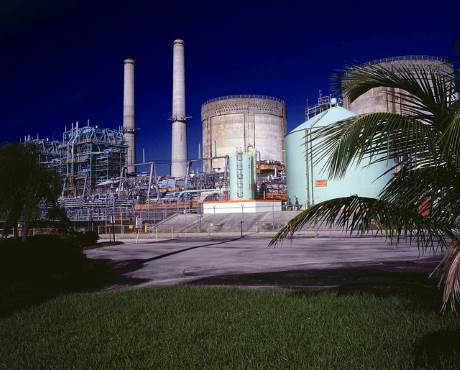Latest reliability and safety indicators for US nuclear power plants continue a pattern of consistently high results dating back more than ten years, according to the US Nuclear Energy Institute (NEI). Meanwhile, an NEI study has shown that Florida's nuclear plants contribute over $1.4 billion per year to the state's economy.
 |
| FPL's Turkey Point 3 and 4 (Image: NRC/FPL) |
The NEI has used key performance indicators from the World Association of Nuclear Operators (WANO) and US organization the Institute of Nuclear Power Operators (INPO) to track the annual performance of the US nuclear industry.
Unit capability factors - a measure of the amount of time a plant is online and producing electricity - stood at 91.7%, close to the 2015 target of 92% and remaining above 91% for the 15th consecutive year. The 59 unplanned automatic or manual reactor shutdowns, also known as scrams, experienced by US plants were the fewest recorded in the last 12 years.
Indicators for 2014 show that US nuclear plants are approaching or already exceeding performance targets for 2015, the NEI notes. Targets are set on a five-yearly basis, so goals for 2015 were set in 2010.
The US plants' high performance levels were matched with exemplary safety performance indicators. According to the WANO and INPO indicators, the main standby safety systems providing defence-in-depth at nuclear power plants have not dropped below 93% in the past 15 years. The 96% availability recorded in 2014 was the highest level since 2008.
2014 was also a record-setting year for plant worker safety, recording 0.03 industrial safety accidents per 200,000 worker hours, well below the 2015 target of 0.1 accidents. "According to the US Bureau of Labor Statistics, it is safer to work at a nuclear power plant than in the manufacturing sector, leisure and hospitality industries, and even the financial sector," the NEI said.
Other indicators including fuel and water chemistry performance, collective radiation exposures, and generating time lost due to unplanned outages showed year-on-year improvements on the previous year.
Nuclear Energy Institute senior vice president and chief nuclear officer Anthony Pietrangelo praised the 100,000-strong workforce in nuclear facilities and their suppliers for their achievements. "Having one great year of performance for an industry or an individual is noteworthy. Being able to sustain that performance over a decade or more is the true measure of excellence," he said.
Florida boost
The NEI has also released a new report highlighting the benefits brought by Florida Power & Light's (FPL) nuclear generating plants to the state's economy. The 25-page analysis of annual data concludes that the St Lucie and Turkey Point nuclear power plants bring over $1.4 billion per year to the state's economy.
In addition to the 700 full-time workers employed at the plants, electricity production at plants stimulates an economic "ripple effect" of economic activity worth $1.2 billion per year. More than 5800 direct and secondary jobs are supported by FPL's nuclear energy operations.
The report also notes that St Lucie and Turkey Point - each home to two pressurized water reactors - are responsible for generating 12% of the state's electricity and 98% of its low-carbon power, making them an essential part of Florida's clean energy portfolio.
NEI's analysis used a nationally recognized impact analysis model to process data from purchase order expenditures, employee compensation and tax payment data. An independent review of the analysis was carried out by Julie Harrington, head of Economic Research Enterprises. Harrington, who is also a director of the Florida State University Center for Economic Forecasting and Analysis, said NEI's economic impact analysis was a "realistic and credible estimate" of the plants' economic impacts.
Researched and written
by World Nuclear News




_18570.jpg)
_16159.jpg)
_18938.jpg)
_33584.jpg)





